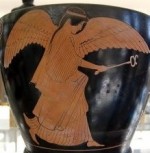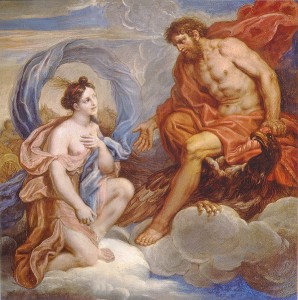 The genus Iris includes over 250 species that range in size from the diminutive Iris danfordiae and I reticulata (4-6”) to tall I. pallid, I. siberica, and I. pseudacorus growing up to 3’. The most common and widely grown iris, however, is the bearded hybrid iris that range in size from 8”-36”. Irises are noted for their great range of color, the characteristic that probably led to their being named after Iris, the Greek personification of the rainbow, the link between heaven and earth.
The genus Iris includes over 250 species that range in size from the diminutive Iris danfordiae and I reticulata (4-6”) to tall I. pallid, I. siberica, and I. pseudacorus growing up to 3’. The most common and widely grown iris, however, is the bearded hybrid iris that range in size from 8”-36”. Irises are noted for their great range of color, the characteristic that probably led to their being named after Iris, the Greek personification of the rainbow, the link between heaven and earth.
The goddess Iris was said to be the daughter of the sea god, Thaumas, and the cloud nymph Electra. The harpies, Aello, Celaeno, and Ocypete, were her sisters. Iris married Zephrus, the west wind, and they had a son Pothos.

Iris is primarily known as the messenger of the gods before Hermes took over the role. At first Iris appears to do the bidding of Zeus but as time went on she took orders from Hera. Like Hermes, Iris carries a caduceus or herald’s rod and sometimes a vessel for carrying water. As a goddess of the sea and sky she supplied water to the clouds. Her wings were golden unlike those of her sister, Arke, who had iridescent wings. She is identifiable in art by her wings and rainbow like nimbus.

Iris was very active as the messenger of Zeus during the Trojan War and some of these scenes are depicted by artists on canvas. In a painting by Vien (1775) Iris rescues Venus who was wounded by Diomedes (Iliad 5.352 ff).

At another time Zeus sent Iris to King Priam to encourage him to retrieve the body of his son Hector from Achilles, shown in her in a work by Felice Giani (1758-1823).

Under totally different circumstances, Iris was sent by Hera to Hypnos, the god of sleep to enlist his help in regard to Ceyx, King of Trachis, in central Greece. The king had left Greece and his beloved wife Alcyone to consult the oracle in far away Anatolia and was killed. Alcyone was sick with worry and fear for his safety and prayed to Hera. After a time, Hera took pity on Alcyone and sent Iris to the god of sleep requesting that he send his son and messenger, Morpheus, to Alcyone to inform her that Ceyx was dead. Morpheus assumed the appearance of Ceyx and appeared in a dream telling Alycone to dreaded news. The moment of Iris’s arrival at the cave of Hypnos is captured by the artist Giulio Carpioni (1613-79).

Pierre-Narcisse Guerin (1811) gives us a closer look at Iris and Morpheus, showing Iris as a beautiful, lovely, young woman.

Iris played an important role as a messenger in many other mythical events but never had any major myths of her own. Few artists have picked up on the events in which she played a part and there is not a lot of art that shows her. She is best remembered by the rainbow and the flowers that bear her name.
